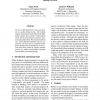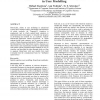HCI
2009
13 years 2 months ago
2009
Heuristic evaluations are an efficient low cost method for identifying usability problems in a biomedical research tool. Combining the results of these evaluations with findings fr...
UM
2010
Springer
13 years 2 months ago
2010
Springer
Semantically-enhanced Ubiquitous User Modeling aims at the management of distributed user models and the integration into ontologies to share user information amongst adaptive appl...
COGSCI
2004
13 years 4 months ago
2004
When people engage in conversation, they tailor their utterances to their conversational partners, whether these partners are other humans or computational systems. This tailoring...
LWA
2004
13 years 5 months ago
2004
User models (UM)the explicit representation of all relevant aspects of a user's preferences, beliefs, etc. form the basis of virtually all adaptive systems. While early appro...
HCI
2001
13 years 5 months ago
2001
In a distributed multi-agent based software environment, the traditional monolithic user model ceases to exist and is replaced by user model fragments, developed by the various so...
LWA
2008
13 years 5 months ago
2008
Several applications support the adaptation of course material. Even though most of these systems allow to specify interaction preferences or even employ user modeling techniques,...
LWA
2008
13 years 5 months ago
2008
Although asynchronous HTTP technologies have grown in importance with the emergence of Web 2.0, most web-based Adaptive Hypermedia Systems (AHS) still exclusively use serverside m...
ACL
2008
13 years 5 months ago
2008
We use an EM algorithm to learn user models in a spoken dialog system. Our method requires automatically transcribed (with ASR) dialog corpora, plus a model of transcription error...
IUI
1997
ACM
13 years 8 months ago
1997
ACM
Historically, efforts at user modelling in educational systems have tended to employ knowledge representations in which symbolic (or "linguistic") cognition is emphasize...
AH
2000
Springer
13 years 8 months ago
2000
Springer
This paper describes an approach to adaptive hypermedia by incorporating linkbases into an agent-based system (PAADS). The agents are built on top of an agent framework developed a...


